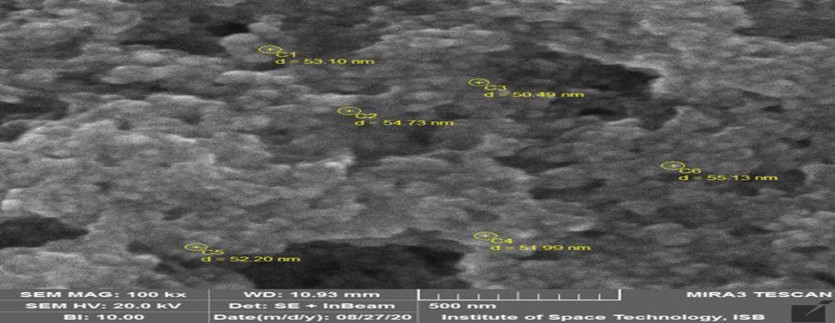
Comparative investigation of effects of phytosynthesized and mycosynthesized based silver nanoparticles on the growth of maize
Abstract
Keywords
Full Text:
PDFReferences
Ajayi, E. and A. Afolayan, 2017. Green synthesis, characterization and biological activities of silver nanoparticles from alkalinized cymbopogon citratus stap. Advances in natural sciences: Nanoscience and nanotechnology, 8(1): 015017.
Akhtar, S., 2015. Food safety challenges—a pakistan's perspective. Critical reviews in food science and nutrition, 55(2): 219-226.
Almutairi, Z. M. and A. Alharbi, 2015. Effect of silver nanoparticles on seed germination of crop plants. Journal of advance agriculture, 4(1): 283-288.
Balakumaran, M., R. Ramachandran, P. Balashanmugam, D. Mukeshkumar and P. Kalaichelvan, 2016. Mycosynthesis of silver and gold nanoparticles: Optimization, characterization and antimicrobial activity against human pathogens. Microbiological research, 182: 8-20.
Barabanov, P., A. Gerasimov, A. Blinov, A. Kravtsov and V. Kravtsov, 2018. Influence of nanosilver on the efficiency of pisum sativum crops germination. Ecotoxicology and environmental safety, 147: 715-719.
Cabiscol Català, E., J. Tamarit Sumalla and J. Ros Salvador, 2000. Oxidative stress in bacteria and protein damage by reactive oxygen species. International microbiology, 2000, 3(1): 3-8.
Esen, A., 1987. A proposed nomenclature for the alcohol-soluble proteins (zeins) of maize (Zea mays L.). Journal of cereal science, 5(2): 117-128.
Fatima, F., S. R. Verma, N. Pathak and P. Bajpai, 2016. Extracellular mycosynthesis of silver nanoparticles and their microbicidal activity. Journal of global antimicrobial resistance, 7: 88-92.
Hussain, S., W. Ahmed, A. Rabnawaz, R. Sohail Jafar, H. Akhtar, W. Guang-Ju, S. Ullah and Y. JianZhou, 2015. Integration and effective supply chain management: A review of agriculture in pakistan and china. Journal of economics and sustainable development, 6(21): 1-5.
Ingle, A., A. Gade, S. Pierrat, C. Sonnichsen and M. Rai, 2008. Mycosynthesis of silver nanoparticles using the fungus fusarium acuminatum and its activity against some human pathogenic bacteria. Current nanoscience, 4(2): 141-144.
Ke, M., Y. Zhu, M. Zhang, H. Gumai, Z. Zhang, J. Xu and H. Qian, 2017. Physiological and molecular response of arabidopsis thaliana to cuo nanoparticle (ncuo) exposure. Bulletin of environmental contamination and toxicology, 99(6): 713-718.
Krishnaraj, C., E. Jagan, S. Rajasekar, P. Selvakumar, P. Kalaichelvan and N. Mohan, 2010. Synthesis of silver nanoparticles using acalypha indica leaf extracts and its antibacterial activity against water borne pathogens. Colloids and Surfaces B: Biointerfaces, 76(1): 50-56.
Liang, L., H. Tang, Z. Deng, Y. Liu, X. Chen and H. Wang, 2018. Ag nanoparticles inhibit the growth of the bryophyte, physcomitrella patens. Ecotoxicology and environmental safety, 164: 739-748.
Ma, C., S. Chhikara, B. Xing, C. Musante, J. C. White and O. P. Dhankher, 2013. Physiological and molecular response of Arabidopsis thaliana (L.) to nanoparticle cerium and indium oxide exposure. Sustainable chemistry & engineering, 1(7): 768-778.
Madakka, M., N. Jayaraju and N. Rajesh, 2018. Mycosynthesis of silver nanoparticles and their characterization. MethodsX, 5: 20-29.
Masurkar, S. A., P. R. Chaudhari, V. B. Shidore and S. P. Kamble, 2011. Rapid biosynthesis of silver nanoparticles using Cymbopogan citratus (lemongrass) and its antimicrobial activity. Nano-Micro Letters, 3(3): 189-194.
Mousavi, S. R. and M. Rezaei, 2011. Nanotechnology in agriculture and food production. Journal of applied envirnment and biological sciences, 1(10): 414-419.
Mukherjee, A., J. R. Peralta-Videa, S. Bandyopadhyay, C. M. Rico, L. Zhao and J. L. Gardea-Torresdey, 2014. Physiological effects of nanoparticulate zno in green peas (Pisum sativum L.) cultivated in soil. Metallomics, 6(1): 132-138.
Muthuraman, M. S., S. Nithya, L. R. Christena, V. Vadivel, N. S. Subramanian and S. P. Anthony, 2019. Green synthesis of silver nanoparticles using nardostachys jatamansi and evaluation of its anti-biofilm effect against classical colonizers. Microbial pathogenesis, 126: 1-5.
Nair, P. M. G. and I. M. Chung, 2014. Physiological and molecular level effects of silver nanoparticles exposure in rice (Oryza sativa L.) seedlings. Chemosphere, 112: 105-113.
Oukarroum, A., S. Bras, F. Perreault and R. Popovic, 2012. Inhibitory effects of silver nanoparticles in two green algae, chlorella vulgaris and dunaliella tertiolecta. Ecotoxicology and environmental safety, 78: 80-85.
Power, A. G., 2010. Ecosystem services and agriculture: Tradeoffs and synergies. Philosophical transactions of the royal society B: biological sciences, 365(1554): 2959-2971.
Prasanna, B. and F. Hossain, 2007. Nanotechnology in agriculture. ICAR National Fellow, Division of Genetics, IARI, New Delhi, 110012.
Qian, H., X. Peng, X. Han, J. Ren, L. Sun and Z. Fu, 2013. Comparison of the toxicity of silver nanoparticles and silver ions on the growth of terrestrial plant model arabidopsis thaliana. Journal of environmental sciences, 25(9): 1947-1956.
Tassi, E., L. Giorgetti, E. Morelli, J. Peralta-Videa, J. Gardea-Torresdey and M. Barbafieri, 2017. Physiological and biochemical responses of sunflower (helianthus annuus l.) exposed to nano-ceo2 and excess boron: Modulation of boron phytotoxicity. Plant physiology and biochemistry, 110: 50-58.
Tenaillon, M. I. and A. Charcosset, 2011. A european perspective on maize history. Comptes rendus biologies, 334(3): 221-228.
Tripathi, D. K., S. Singh, S. Singh, R. Pandey, V. P. Singh, N. C. Sharma, S. M. Prasad, N. K. Dubey and D. K. Chauhan, 2017. An overview on manufactured nanoparticles in plants: Uptake, translocation, accumulation and phytotoxicity. Plant physiology and biochemistry, 110: 2-12.
Zuverza-Mena, N., D. Martínez-Fernández, W. Du, J. A. Hernandez-Viezcas, N. Bonilla-Bird, M. L. López-Moreno, M. Komárek, J. R. Peralta-Videa and J. L. Gardea-Torresdey, 2017. Exposure of engineered nanomaterials to plants: Insights into the physiological and biochemical responses-a review. Plant Physiology and Biochemistry, 110: 236-264.
DOI: https://doi.org/10.33865/wjb.006.03.0449
Refbacks
- There are currently no refbacks.
Copyright (c) 2021 Yasmin Akhtar, Abida Akram, Naveed Iqbal Raja, Ghulam Yaseen Awan

This work is licensed under a Creative Commons Attribution 4.0 International License.
Print ISSN: 2522-6746 : Online ISSN: 2522-67541. How to register 2. How to reset password2. How to prepare a manuscript before submission 3. How to submit a paper 4. How to check the review status of a paper5. How to check the plagirisim or similarity report